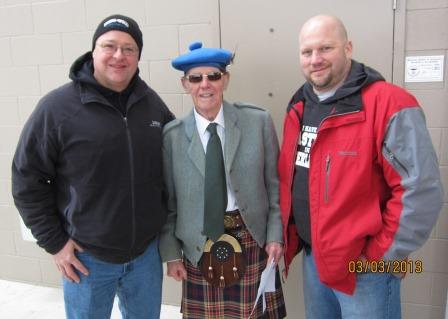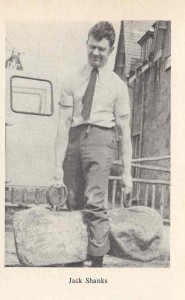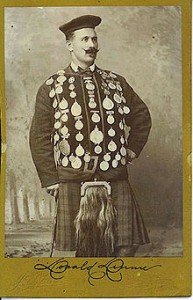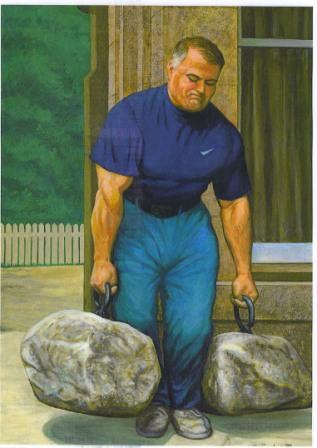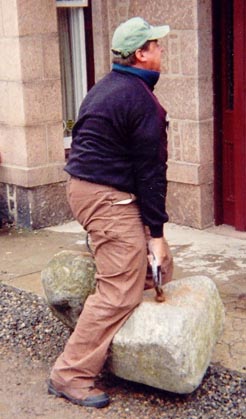by Al Myers
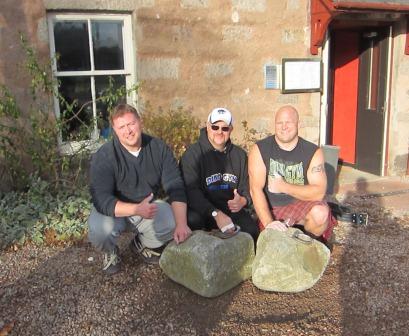
The three that lifted the Dinnie Stones unassisted (without straps) - (left to right): Mark Haydock, Al Myers, and Chad Ullom
One of the most exciting experiences of my life occurred the day following the IAWA Gold Cup. Gold Cup promoters Andy Tomlin and Matthew Finkle arranged an organized trip to visit the famous Dinnie Stones. This trip was planned and announced many months in advance and several IAWA lifters took part. Participants included men from Scotland, England, United States, and Finland. As we were making the road trip to the Potarch Hotel and crossing through the beautiful Scottish Highlands and the snow covered Cairngorm Mountains, anxiety and anticipation filled the atmosphere of the car. Once we arrived it was exciting to see several locals had showed up to witness our efforts. Apparently the word had gotten out! I would say there were 10-15 people in attendance to watch our efforts in undertaking the challenge of lifting the Dinnie Stones.
Donald Dinnie left these stones for future generations to test their strength. I have previously read the book, “Donald Dinnie – The First Sporting Superstar” by David Webster and Gordon Dinnie several times, and it is a tremendous account of Donald Dinnie and his achievements. Anyone should read this book before making the trip to the Potarch Hotel to fully realize and recognize the historical significance of these stones. The latest issue of MILO (September, 2012 Volume 20, Issue 2) included an excellent Dinnie Stone article written by the legendary Scottish Highland Game athlete Francis Brebner. I have read several articles concerning the Dinnie Stones, and this article by Francis is the best one I have ever read. I have had the opportunity to “share the throwing field” with Francis in several past professional Highland Games, and I can attest firsthand what an upstanding individual Francis is in the strength community. Another important reference should be the Dinnie Stone website http://gordondinnie.com/Stones.html , which includes many of the successful lifts by strong men in past history. The top of the website lays out the challenges made by Donald Dinnie and his stones in his own words, which I would like to repeat here:
The stones weighing a total of 785lbs. were carried by Donald Dinnie in 1860.
Here is Donald’s own account of the event written by him in 1912.
“On the granite stone bridge that crosses the River Dee at Potarch there were, and still are, two large stones weighing about 8cwt the pair, placed in a recess. In the early 1830’s massive iron rings were placed in them, to which ropes were fixed so that scaffolds could be attached for pointing the bridge. Now, one of these stones was somewhat heavier than the other. Very few strong men of that day could lift the heavy one withbothhands, but my father could raise one in each hand with apparent ease, and could throw the heavier stone of the two on to the top of a parapet wall of the bridge. Those stones are still on the bridge and I myself lifted one in each hand on many occasions and one market day, I carried them across the bridge and back, some four to five yards.”
It is easy to see from those words that three challenges were issued by Donald Dinnie regarding the Dinnie Stones, 1. Lift the stones for height (to the top of a parapet wall) 2. Lift the stones for repetitions (lifted one in each hand on many occasions) and 3. Carry them for distance (carried them across the bridge and back, some four or five yards).
The Dinnie Stones represent a different individual challenge for every person. Lifting stones is NOT a weightlifting meet – there is no trophy for winning or being the best. I feel anyone who meets the challenge that they set out for themselves with the Dinnie Stones is worthy of praise, as this is what stone lifting should be all about. It’s a inner battle against the stone that lays before you which drives you to “rise to the occasion” and give everything that you have, both mentally and physically, to accomplish the goal set forth. If you do that, you have been successful in your quest and should know in your heart that by doing so you have met the challenge of the Dinnie Stones. The degree of this challenge is different for every man.
Now let me get to the details of this glorious day of those that had taken part!! I kept very accurate records of the accounts of the day as I want this to be reported with accuracy. Ten men took part in this memorable event. Below is a summary chart of what transpired:
| Participant |
Age |
BWT |
Dinnie Stone Accomplishment |
| Alex Rigbye, ENGLAND |
27 |
89kg |
7 Repetitions with both stones assisted (WITH STRAPS) |
| Josh Haydock, ENGLAND |
22 |
80kg |
1 Repetition with both stones assisted (WITH STRAPS), and 3 Repetitions with small stone unassisted |
| Barry Gordge, ENGLAND |
51 |
104kg |
1 Repetition with small stone unassisted |
| George Dick, SCOTLAND |
64 |
123kg |
1 Repetition with small stone using both hands unassisted |
| Mark Haydock, ENGLAND |
37 |
115kg |
25 Repetitions with both stones unassisted, walk with both stones unassisted a total of 3 feet |
| Chad Ullom, UNITED STATES |
40 |
112kg |
25 Repetitions with both stones unassisted |
| Andy Tomlin, SCOTLAND |
45 |
92kg |
Lifted both small and large stone one handed unassisted |
| Timo Lauttemaus, FINLAND |
33 |
98kg |
Lifted large stone unassisted with left hand and held for a time of 14.3 seconds |
| Matt Finkle, SCOTLAND |
46 |
65kg |
Lifted both small and large stone with two hands unassisted |
| Al Myers, UNITED STATES |
46 |
111kg |
1 Repetition with both stones unassisted |
(NOTES: I want to mention that these ages and bodyweights are official, as they were used in entry in the previous days’ IAWA Gold Cup Championships. Also, I want to thank James McKenna for attending this activity, as he was the one responsible for several of the pictures that were taken. The Dinnie Stone lifting took place over an hour and a half, from 10:30 AM to noon on November 4th., 2012)
I was so impressed with Alex Rigbye and Josh Haydock. These two young men brimmed with enthusiasm, and gained much respect from myself and others by their tenacity. Josh was set on trying to lift both stones unassisted, and tried numerous times to no avail. He easily lifted the small stone unassisted, but the large stone was just slightly out of his capabilities. It surely wasn’t because of lack of effort! He tried and tried, and then totally exhausted resorted to using lifting straps to complete one good repetition of both stones. It was a gallant lift, considering that he had previously “given it all”. Alex was intent on getting as many reps as he could using straps, and “gutted out” 7 repetitions. I told both of these young men what an outstanding effort they had given, and that they should use this day to give them the motivation to come back in future years and succeed lifting the stones unassisted. I KNOW that they will do that – as the challenge of the Dinnie Stones is now embedded in their soul.
I had just met Barry Gordge for the first time this weekend. Barry, at age 51, is one strong man. The day before I watched Barry do a one arm Zercher of 142.5 kgs. Barry lifted the small stone quite easily one handed unassisted. This was his first experience taking on the Dinnies. He did not try to use straps to lift both of them together – but if he would have I know that he would have had no problem lifting both of them at the same time.
George Dick and Matt Finkle came focused on lifting both stones two handed. George handled the small Dinnie Stone several times as well as Matt. After a few failed attempts at the big stone two handed, Matt finally succeeded! It was one of the most impressive lifts of the day. Matt only weighs 65 kilograms and I am sure the large stone is exceeding his max deadlift. Holding onto the Dinnie Stone ring is WAY HARDER than gripping a bar, but due to his persistence he was successful!
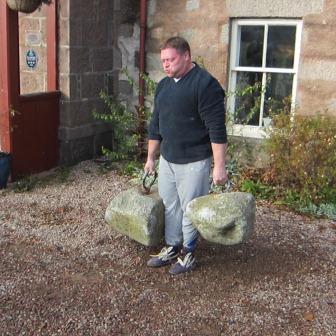
This is one of the 25 reps done by Mark Haydock during the course of the day.
Mark Haydock and Chad Ullom came into the day only hoping to be successful lifting both stones unassisted (without straps). Both had never attempted the Dinnie Stones before, and even though they knew their capabilities lifting on ring handled pin loaders, these stones offer different challenges with unknown uncertainties. Mark has just recently (5 months ago) had bicep reattachment on his right bicep. Anyone would have to question his sanity in attempting such a thing. Both of these guys were very “fired up” on their first attempt, and proceeded to lift the Dinnie Stones unassisted for one repetition with ease! After doing this, they decided to go after more repetitions to fully test their capabilities. I sat back and watched in amazement! Once they got close to 20 repetitions, I suggested that they go for 25 total reps as that would mark the 25 year celebration of the International All Round Weightlifting Association. This challenge I issued pushed them a few reps further. I want to emphasize that all these reps were done WITHOUT STRAPS. I will never take away from anyone lifting the Dinnie Stones with straps, as if that was the challenge they were presented with and succeeded then success was obtained. But lifting the Dinnie Stones unassisted (without straps) is a challenge of a much higher level, and no one should be fooled in thinking lifting with straps is the same as lifting without. The limit is the ability to hold the grip, and both Mark and Chad have WORLD CLASS hook grips to go along with their strong backs. I believe that this is the most repetitions anyone has ever lifted the Dinnie Stones in one day, which is a great accomplishment. As I’ve said earlier in this story, total repetitions have always been a part of Dinnie Stone lifting history, as recorded on the Dinnie Stone website. Well over 50% of all Dinnie Stone lifters on that website have pushed their body limits with repetitions.
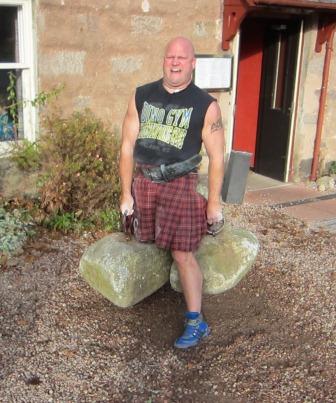
Chad Ullom with a successful unassisted lift with the Dinnie Stones.
Mark also took “a shot” at walking with both Dinnie Stones without straps. In Francis’s article, he talked about two other athletes walking with the stones in the past. Calum Morrison was one of the first to do so, walking 2 feet in 1997. Glenn Ross was another who attempted to match Donald Dinnie’s feat of crossing the bridge carrying both stones (a distance slightly over 5 yards). Ross gave a ferocious attempt, making it 5 feet 5 inches. I was slightly surprised Mark was even going to give this a try, after already lifting the stones for many repetitions. I thought his grip obviously had to be impaired from this previous lifting. But not only did he walk a total of 3 feet – he didn’t use straps!!! He lifted the stones “side by side” and with the stones beating on his legs with every small step, he moved slowly over the distance. I should mention that Mark did this in the soft gravel out in front of the hotel, and chose his course slightly uphill toward the street. This HAS to be one of the most impressive feats ever done with the Dinnie Stones. If there is a man to match Donald Dinnies feat of carrying the stones across the bridge without sitting either one down – my money is on Mark. I want to make another comment about Mark and Chad’s Dinnie Stone lifting efforts. All of the lifts were done on the soft gravel out of respect of not damaging the stones. Several times I saw Chad’s feet slip on the loose gravel as he started his pull, which caused him to abandon the attempt and reset. This added much more challenge to their efforts. I have watched lifters on YouTube lift the Dinnie Stones on the concrete, and you can hear the “thub” every time when the stones are set down after their attempts. This makes me shudder and cringe. We, as stone lifters, need to take care of these stones for future generations. Mark and Chad are very humble guys as well, you will never hear of them “bragging” about their successes with the Dinnie Stones in the future.
Timo Lauttemaus has to be one of the first lifters from Finland to lay hands on the Dinnie Stones. Timo has huge hands, and the day before did a 127.5 kg Index Finger Deadlift. However, the technique of hook gripping is new to him. Chad and I explained the process of hook gripping in the car on the way to the Potarch Hotel. So what does he do? He hooks grip for the FIRST TIME ever and lifts the big Dinnie Stone with his left hand and holds it for 14.3 seconds!! Unbelievable if you ask me.
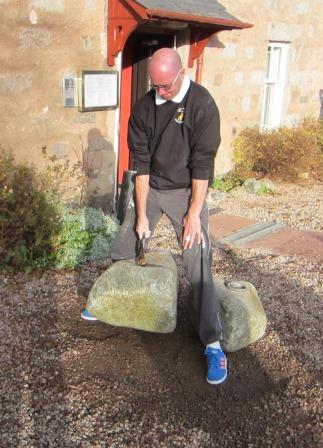
Andy Tomlin successful with the large stone one handed unassisted. Andy and Matt Finkle were responsible for organizing this trip to the Dinnie Stones.
This was the third trip to the Dinnies for Andy Tomlin. He had previously lifted the small stone with one hand, but never the big one. He had the goal to lift the big one unassisted, and that is JUST WHAT HE DID. It took a few attempts, but Andy “reached down deep” and gave one of the greatest efforts of the day. After overcoming the many years disappointment with this big Dinnie Stone – he was finally successful!
I can’t end this story without giving my account with my Dinnie Stone battle. The first time I gave a shot at lifting the Dinnie Stones was in 2005. At that time I was much stronger having around a 750 pound deadlift, but lacked the hook grip strength to lift the big stone. I tried and tried on that occasion. I told myself that I would come back at a latter date and succeed with this quest. At that time I elected not to use straps as I knew I could lift them easily that way and I felt that that wasn’t my Dinnie Stone Challenge. I wanted my first time to lift them to be unassisted. However, I didn’t think that this trip would be that time yet. I just recently had shoulder surgery (2 months ago), and haven’t been able to train with my left arm at all, and was concerned that attempting them may injure myself as I’m still recovering. I didn’t even take my lifting belt with me on the trip to the Dinnies. However, once there and watching everyone else push themselves with their challenges, I had a change of mind as I felt the draw of the Dinnie Stone mystic overtake me. I borrowed Chad’s belt for my attempt. My first try I set my hook too deep and tore a huge chunk of flesh from my palm. As I looked down I could see the blood trickling from my hand onto the large stone. It took 10 minutes to get the bleeding to stop. For a split second I thought “its got to be another day for me now”, but then I lost all rational thought and gave them another shot. With no negative thoughts in my head, I gave it all I had and they came up!! A goal I set for myself 7 years prior was now realized. I told Mark and Chad afterwards that my one rep meant just as much to me as their 25 reps did to them! That’s what the Dinnie Stones should be all about – taking on a challenge and being successful with great effort and determination.
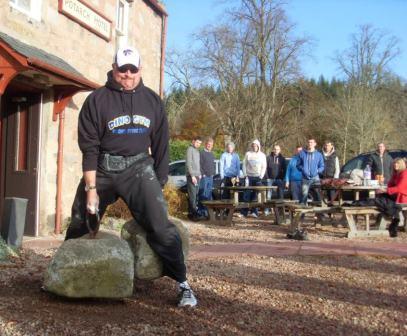
Al Myers making a successful unassisted lift with the Dinnie Stones in front of a crowd on spectators.
This was a day that those of us involved will never forget in our lives. I am proud of the fact that all of us are DRUG FREE, and have the negative tests to back up that statement. Lots of blood and sweat were left on the Dinnie Stones (luckily no tears), but we left them in the same state as when we arrived for the next stone lifter to test his fortitude against the mighty challenge of the Dinnie Stones. I am glad that I was able to be part of this day as it will forever tie all of us to the legacy of the Stones. Talks are already underway for our next organized trip to the Dinnie Stones – where new challenges will be set and higher achievements will be made.
